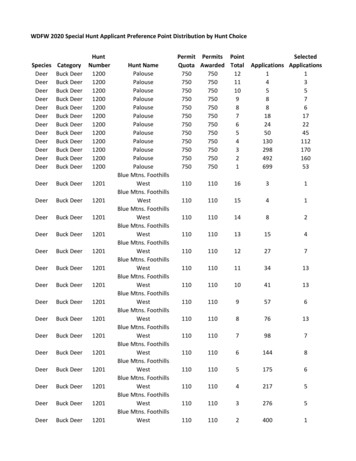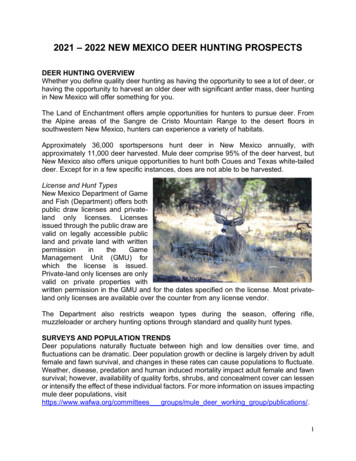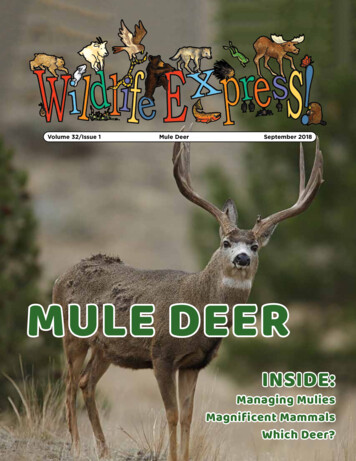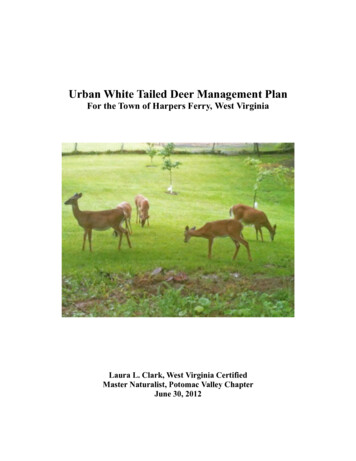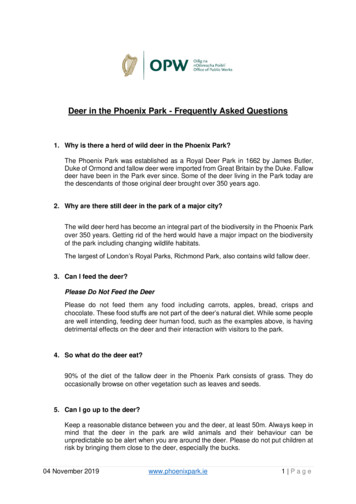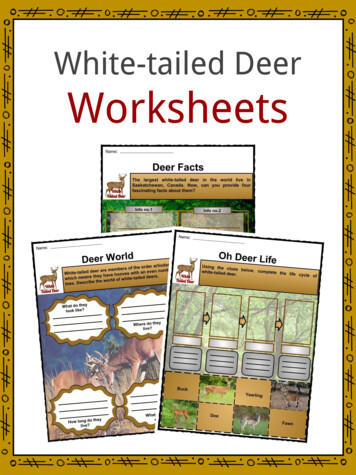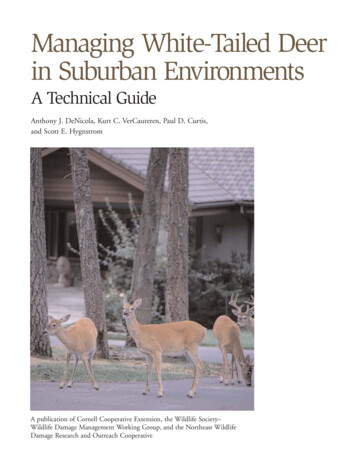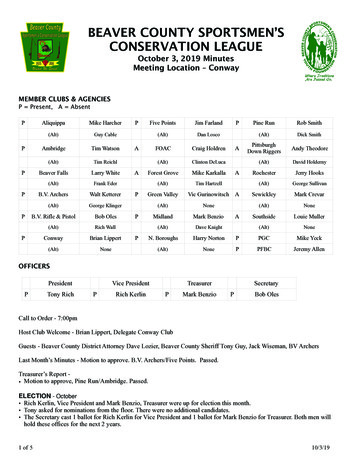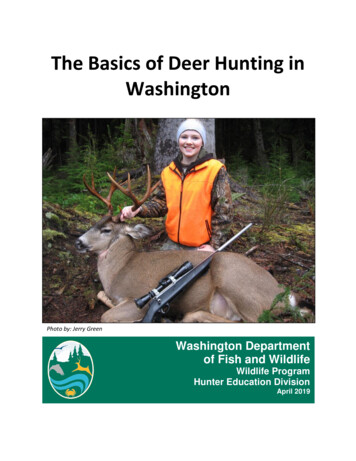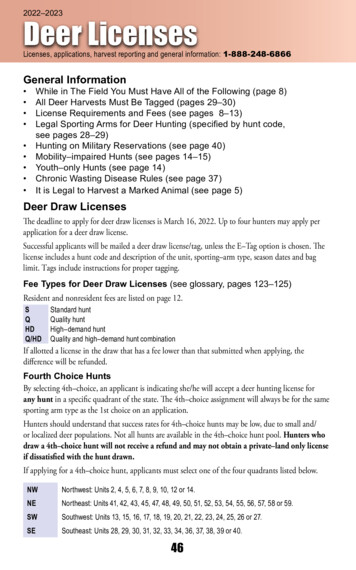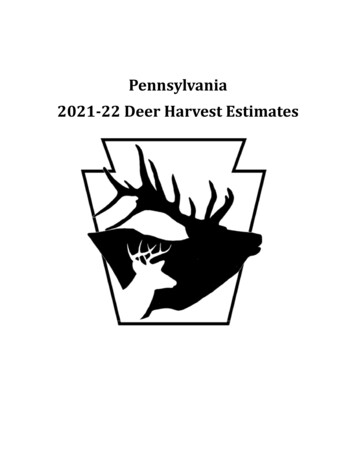
Transcription
Pennsylvania2021-22 Deer Harvest Estimates
2IntroductionThe Pennsylvania Game Commission (PGC) uses a report card registration system for hunters toreport the harvest of each white-tailed deer in combination with field-checked deer to estimatereporting rates by type of deer (antlered versus antlerless), and deer management unit (DMU).Reporting rates and report card counts are used to estimate harvest by DMU for antlered andantlerless deer. Traditionally, the PGC has field-checked harvested deer only during the regularrifle seasons when most deer are harvested and has used these reporting rates to estimate harvestin all other seasons (e.g., early and late archery and muzzleloader seasons). Harvests werecalculated as:H N RC;(1)r3 yearwhere H is the calculated harvest, NRC is the number of report cards, and r is the reporting ratebased on a 3-year running average. Harvests are calculated for antlered and antlerless deer bydeer management unit, but no measure of precision was determined.A recent evaluation of this method validated the science behind the PGC's method of samplingharvested deer and estimating reporting rates (Rosenberry et al. 2004). Based on results of thisevaluation, a new method of estimating deer harvests was implemented for the 2004-05 huntingseasons. The new method no longer calculates a harvest estimate based on a 3-year runningaverage. Rather, it estimates an annual harvest based on year-specific data. In addition, the newmethod provides a harvest estimate (as compared to calculated) with appropriate measures ofprecision (e.g., variance, standard error, coefficient of variation). This additional informationpermits an evaluation of the reliability of deer harvest estimates that was not possible in the past.MethodsBeginning in 2004-05, deer harvests are estimated using a mark-recapture technique that issimilar to the method we use to estimate bear populations. As a result of their widespread useover a long time period, much work has been done on application of mark-recapture techniquesunder many different scenarios. When estimating deer harvests, a closed, two-sample LincolnPetersen estimator is used. Deer are considered marked when they are checked in the field bydeer aging teams. The recapture occurs when marked deer are reported on report cards sent in byhunters.Assumption of the Lincoln-Petersen estimator include:1. The sampled population is closed.2. All animals are equally likely to be captured in each sample3. Data are recorded correctly.Assumption 1. Closed Population. The sampled population is the annual deer harvest. Additionsto this population occur throughout the hunting seasons; however, once deer aging activities areDeer and Elk Section, Bureau of Wildlife ManagementMarch 10, 2022
3completed, the marked sample will not change. Additions only occur as unmarked animals thatcontinue to be reported throughout the deer hunting seasons. As a result, the closure assumptioncan be relaxed and the Lincoln-Petersen estimator remains valid for estimating the harvest onceall report cards are tallied (Pollock et al. 1990).Assumption 2. Equal catchability. This assumption is difficult to meet in most wildlife situations(Pollock et al. 1990, Thompson et al. 1998). For estimating deer harvests, the assumption that allanimals are equally likely to be included in each sample refers to a harvested deer's chance beingin both the marked sample and reported sample. Our marking procedures at processors and otherspecific locations do not provide an equal chance of being marked because some deer will not betaken to a processor. One method of relaxing this assumption is to use different methods formarking and reporting. In the case of deer harvest estimates, if the probabilities of a deer beingmarked and being reported are independent, Lincoln-Petersen estimates will be unbiased (Seber1982). Available evidence indicates that our marked sample is representative of the harvest andtherefore should not bias our results (Rosenberry et al. 2004).One known problem with reporting rates is they differ by seasons (Rosenberry et al. 2004). As aresult, early seasons such as archery and October muzzleloader and rifle season estimates wouldbe biased high. This is an issue that warrants further investigation; however, the effect on theoverall harvest estimate is minimal because most deer are harvested during the regular firearmsseason (Rosenberry et al. 2004).Assumption 3. Data recorded correctly. This assumption is met through accurate recording andentering of data into databases. Validation programs are used to check data for accuracy.Based on the assumptions of the Lincoln-Petersen estimator and the characteristics of oursamples, the Lincoln-Petersen estimator is an appropriate method for estimating deer harvests.Because reporting rates in Pennsylvania vary by year, antlered and antlerless deer, and DMU(Rosenberry et al. 2004), annual deer harvest estimates are calculated for antlered and antlerlessdeer in each WMU using Chapman's (1951) modified Lincoln-Petersen estimator;(n 1)(n2 1)Hˆ 1 1;(m2 1)(2)where Ĥ is the harvest estimate, n1 is the number of deer marked by deer aging teams, n2 is thenumber of deer reported via report cards by hunters, and m2 is the number of deer marked bydeer aging teams and reported via report cards by hunters. This estimator is recommended(Nichols and Dickman 1996) because it has less bias than the original Lincoln-Petersen estimator(Chapman 1951).Deer and Elk Section, Bureau of Wildlife ManagementMarch 10, 2022
4Approximately unbiased variance of the harvest estimate Var( Ĥ ) is estimated as;( n 1)( n 1)( n m )( n m )121222;Var ( Hˆ ) 2( m 1) ( m 2 )22(3)from Seber (1970).ResultsBy using mark-recapture estimators, more information is now available on precision of harvestestimates. Prior to 2003-04, calculated harvests were provided to the public with impliedprecision of a single deer (e.g., 517,529). In 2003-04, precision of calculated deer harvests wasreported to the nearest ten deer (e.g., 464,890). In each case, implied precision of deer harvestsoverestimated the actual precision, but no methods of estimating precision were utilized. This isno longer the case and measures of precision are available for each harvest estimate.Consequently, more information can now be conveyed to the public regarding deer harvestestimates.There are a number of options for presenting deer harvest results to the public. From a statisticalviewpoint, the most appropriate presentation might include point estimates plus or minusstandard errors or with confidence intervals. From a public relations standpoint, the mostappropriate presentation may be point estimates. A concern with the statistical presentation isthat all the numbers could be confusing to the general public and a concern with point estimatesis the implied precision because point estimates are calculated to the single deer. An alternative,to both of these extreme cases, is to provide point estimates rounded to an appropriate number offigures. For example, if the precision of the harvest estimate is less than 1,000 based on thestandard error, the harvest estimate would be rounded to the nearest 100. If the precision of theharvests estimate is greater than 1,000 based on the standard error, the harvest estimate would berounded to the nearest 1,000. In the wildlife management literature, standard errors arecommonly presented with point estimates as a measure of precision.Season HarvestsOverall harvests are broken down into archery, regular firearms, and muzzleloader harvests, notbecause these numbers are used for deer management purposes, but because the public requeststhem. The overall removal of deer from a population during all hunting seasons is the parameterof greatest management interest. Whether a deer was harvested with a bow, muzzleloader, orrifle has limited value for management recommendations. Based on an evaluation ofPennsylvania's harvest estimates, attempting to calculate archery and muzzleloader harvestsbased on report cards and reporting rates results in biased numbers (Rosenberry et al. 2004),because hunters during the October seasons (archery, early muzzleloader, and October rifle)report deer harvests at a higher rate than hunters during the regular firearms season. This is aknown problem with presenting archery and muzzleloader harvests, but it has minimal effect onDeer and Elk Section, Bureau of Wildlife ManagementMarch 10, 2022
5total harvests (Rosenberry et al. 2004) that are used for management purposes. Since seasonharvest estimates are expected by the public, we modified our method of calculating seasonharvests in 2007-08. Prior to 2007-08, we simply divided the overall harvest into season harvestsusing the proportion of report cards received during each type of season. For example, if 20% ofthe report cards were from archery season, then 20% of the harvest was identified as archeryharvest. In 2007-08, we modified this slightly. First, we estimated the total deer harvests for allseasons. Second, we estimated the firearms season harvest using the animals we checked in thefield, the number of those animals reported by hunters, and the number of report cards from thefirearms season. We then subtracted the firearms season harvest from the overall harvest leavingonly those deer killed during the archery and muzzleloader seasons. These remaining deer weredivided into archery and muzzleloader harvests using the proportion of report cards similar toprevious years. The primary difference between the current method and the previous method isthat it should reduce bias in archery and muzzleloader harvests because the firearms harvest isestimated based on field data and not proportion of report cards.Literature CitedChao, A. 1989. Estimating population size for sparse data in capture-recapture experiments. Biometrics 45:427-438.Chapman, D. G. 1951. Some properties of the hypergeometric distribution with applications to zoological censuses.University of California Publications on Statistics 1:131-160.Nichols, J. D. and C. R. Dickman. 1996. Capture-recapture methods in Measuring and monitoring biologicaldiversity: standard methods for mammals. D. E. Wilson, F. R. Cole, J. D. Nichols, R. Rudran, and M. S.Foster editors. Smithsonian Institute Press, Washington D.C.Pollock, K. H., J. D. Nichols, C. Brownie, and J. E. Hines. 1990. Statistical inference for capture-recaptureexperiments. Wildlife Monographs 107.Rexstad, E. A. and K. P. Burnham. 1992. User's guide for interactive Program CAPTURE. Colorado CooperativeFish and Wildlife Research Unit, Colorado State University, Fort Collins, Colorado.Rosenberry, C. S., D. R. Diefenbach, and B. D. Wallingford. 2004. Reporting rate variability and precision of whitetailed deer harvest estimates in Pennsylvania. Journal of Wildlife Management 68:860-869.Seber, G. A. F. 1982. The estimation of animal abundance and related parameters, Second edition. Charles Griffinand Company LTD. London.Thompson, W. L., G. C. White, and C. Gowan. 1998. Monitoring vertebrate populations. Academic Press, NewYork, New York.Williams, B. K., J. D. Nichols, and M. J. Conroy. 2002. Analysis and management of animal populations. AcademicPress, New York, New York.Deer and Elk Section, Bureau of Wildlife ManagementMarch 10, 2022
6HARVEST ESTIMATES, 2021-22Overall Harvest 017,50019,70010,30024,90021,3008,900110376,810Deer and Elk Section, Bureau of Wildlife ManagementMarch 10, 2022
7Archery Harvest Estimates(Includes harvests taken with archery methods, outside of the general firearms 2806,8904,3901062,070Deer and Elk Section, Bureau of Wildlife 5,0806,3603,58012,32011,6206,47010130,650March 10, 2022
8Regular Firearms Season Harvest Estimates(Includes all harvests taken during the general firearms season, regardless of hunting 1004,4008,5007,0001,70080149,380Deer and Elk Section, Bureau of Wildlife 00March 10, 2022
9Muzzleloader Harvest Estimates(Includes harvests taken with a muzzleloader, outside of the general firearms 09706001,320810210020,040Deer and Elk Section, Bureau of Wildlife 30021,060March 10, 2022
10ANNUAL CHANGESOverall Harvest EstimatesTotal Harvest EstimatePercent 021,3008,900110376,810Deer and Elk Section, Bureau of Wildlife ManagementPreviousYearPrevious %12%20%-1%-8%1%-13%-6%March 10, 2022
11Antlered HarvestsAntlered Harvest EstimatePercent 005,7007,2007,9003,1007,8006,6002,60020145,320Deer and Elk Section, Bureau of Wildlife ManagementPreviousYearPrevious 34%-14%-17%3%-7%-19%-16%7%-17%-10%March 10, 2022
12Antlerless HarvestsAntlerless Harvest EstimatePercent evious 8%38%11%-4%-2%-11%-3%.Deer and Elk Section, Bureau of Wildlife ManagementMarch 10, 2022
13DATA USED TO ESTIMATE DEER &TotalHarvestin Field Reported Reported 31,1932,6007206,0742,13851,436145,3201- Published harvest estimates are estimated using a Mark-Recaptureestimator and are rounded to the nearest 100 or 1,000 depending onprecision of the estimate.2- UNK calculated as total unknown reported divided by statewidereporting rate, rounded to 10sDeer and Elk Section, Bureau of Wildlife ManagementMarch 10, 2022
alHarvestin Field Reported Reported 5,5764,76570,628231,4901- Published harvest estimates are estimated using a Mark-Recaptureestimator and are rounded to the nearest 100 or 1,000 depending onprecision of the estimate.2- UNK calculated as total unknown reported divided by statewidereporting rate, rounded to 10sNOTE: CWD DMAP permits not included in ‘Total Reported’.Deer and Elk Section, Bureau of Wildlife ManagementMarch 10, 2022
15COMMENTS Reporting rates remain low. Antlered 35% (Range: 27% to 44%), Antlerless 31% (Range:25% to 43%) Majority of deer were reported online. 70% of deer harvest reports were online, 22% were onreport cards, and 8% were by phone. Harvest estimates are based on more than 21,000 deer checked by Game Commissionpersonnel and more than 122,000 harvest reports submitted by successful hunters. Harvest estimates are calculated using a common wildlife management technique called‘mark-recapture’. Data used to estimate harvests includes 2 data sets; 1) data collected in thefield by Game Commission deer aging teams and 2) reports from successful hunters. For a full explanation of harvest estimating procedures, including example calculations, seepages 55 to 59 in the deer management plan. The plan is available on the PGC’s website,www.pgc.pa.gov, click on “Popular Hunting Pages” at bottom of home page, then “Whitetailed deer”, then under “Deer Management”.Antlered Harvests Antlered harvest decreased an average of 15% from the 2020-21 season. Age structure of this year’s harvest was 38% 1.5 year old bucks and 62% 2.5 year old andolder bucks. Comparisons between the current year’s harvest and historic antlered harvests often do notconsider hunter numbers. In 1986, there were 1,000,000 deer hunters in Pennsylvania. Today,there are around 650,000 deer hunters. When corrected by the number of hunters, successrates are higher today than in the past, even with antler-point restrictions.o Historic Antlered Deer Hunter Success Rates versus Recent1987-8816% of deer hunters harvested an antlered deer1997-9819% of deer hunters harvested an antlered deer2007-0815% of deer hunters harvested an antlered deer2017-1823% of deer hunters harvested an antlered deer2018-1922% of deer hunters harvested an antlered deer2019-2025% of deer hunters harvested an antlered deer2020-2126% of deer hunters harvested an antlered deer12021-2222% of deer hunters harvested an antlered deer1Current year deer hunter numbers are not available until later this year, so are based on previous year.Antlerless Harvests Age structure of this year’s harvest was 69% adult females, 16% button bucks, and 15%doe fawns, consistent with long-term averages. Antlerless hunter success rates remained around 25% (approximately a quarter of allantlerless licenses were used to harvest an antlerless deer). This is on average withharvest success for recent years.Deer and Elk Section, Bureau of Wildlife ManagementMarch 10, 2022
(Rosenberry et al. 2004), annual deer harvest estimates are calculated for antlered and antlerless deer in each WMU using Chapman's (1951) modified Lincoln-Petersen estimator; 1 ( 1) Ö ( 1)( 1) 2 1 2 m n n H; (2) where HÖ is the harvest estimate, n 1 is the number of deer marked by deer aging teams, n 2 is the
